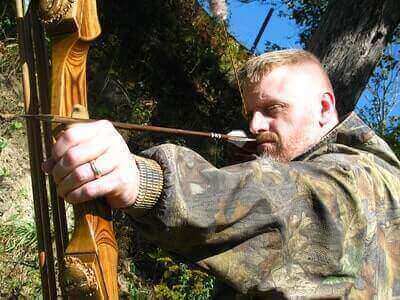Disclosure: We may earn commissions if you purchase products after clicking on a link from our site.
If you’re new to hunting with recurve bows, you may want to know how to hunt with recurve bows. It can be a little daunting learning how to hunt with a recurve bow, but with a little practice and attention to detail, you can get good at it if you put in the work. In this article, we discuss how to hunt whitetail deer with a recurve bow.
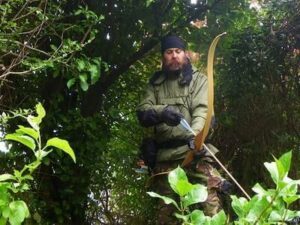
Table of Contents
How To Hunt With Recurve Bows
1. Choose The Right Bow
Not all recurve bows are created equal. You will want to choose a bow that is comfortable for you to hold and that has the right amount of power for the game you are hunting. You can read about the best recurve bows on the market today from this article.
Choosing the right bow is crucial when learning how to hunt with a recurve bow. Factors such as draw weight, draw length, and overall bow length should be carefully considered to ensure a comfortable and effective shooting experience.
For beginners, starting with a lower draw weight allows for proper form development and reduces the risk of overexertion or injury. As skills progress, the draw weight can be gradually increased.
Additionally, selecting a bow with an appropriate draw length ensures proper arrow flight and accuracy. The overall length of the bow also influences maneuverability in tight hunting situations, so choosing a bow that strikes a balance between power and maneuverability is essential.
Finally, factors such as budget, brand reputation, and personal preferences should also be taken into account when selecting the right recurve bow for hunting endeavors. Consulting with experienced archers or seeking guidance from knowledgeable archery professionals can provide valuable insights into making an informed decision.
2. Practice, Practice, Practice
Before you head out into the field, make sure you practice with your bow. The more you practice, the better your aim will be.
Practicing with the bow is indispensable when learning how to hunt with a recurve bow. Consistent practice not only hones shooting skills but also builds muscle memory and strengthens archery fundamentals.
Beginners should focus on mastering proper shooting form, including stance, grip, anchor point, draw, aim, and release. Regular practice sessions should incorporate various distances, angles, and shooting scenarios to simulate real hunting conditions.
Additionally, practicing in different weather conditions, such as wind or rain, helps develop adaptability and confidence in challenging environments. As proficiency improves, advanced techniques like instinctive shooting or shooting from elevated positions can be introduced. Moreover, practicing ethical hunting practices, such as shot placement and tracking, enhances effectiveness and ensures humane kills. Ultimately, dedicating time to consistent and focused practice is key to becoming a skilled and successful recurve bow hunter.
3. Be Patient
Hunting with a recurve bow takes time and patience. Don’t get discouraged if you don’t see results immediately. Stick with it and eventually, you will be a successful hunter.
Patience is a virtue essential for those learning how to hunt with a recurve bow. Unlike modern compound bows, recurve bows require a deeper understanding of archery principles and a higher level of skill to master.
Beginners must acknowledge that proficiency with a recurve bow takes time and dedication. Developing proper shooting technique, accuracy, and consistency demands patience and persistence. It’s crucial to resist the temptation to rush the learning process and instead embrace each step of improvement.
Patience also plays a vital role in the hunting aspect, as success in the field often requires long periods of waiting and observation. Learning to remain calm and composed during hunts, even in the face of setbacks or challenges, is key to becoming a proficient recurve bow hunter. With patience as a guiding principle, aspiring hunters can steadily progress and ultimately achieve success in both archery and hunting endeavors.
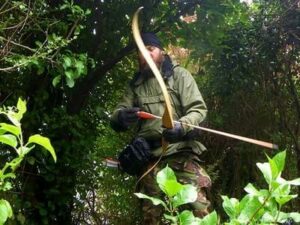
4. Draw Weight
It is not necessary to opt for excessive draw weight for hunting deer with a recurve bow. However, the more weight you can shoot with, the better. A good draw weight to start with is 45 pounds. A bow of 45 to 55-pound draw weight will provide the force required to be a deadly shot from 20 yards or less.
Choosing the right draw weight is a crucial consideration for those learning how to hunt with a recurve bow. It’s essential to select a draw weight that matches your physical strength, shooting ability, and hunting goals. Opting for a draw weight that is too heavy can lead to fatigue, inconsistency in shooting, and potential injury.
Conversely, a draw weight that is too light may lack the power necessary for ethical hunting kills. Beginners should start with a draw weight that allows them to comfortably draw the bow while maintaining proper form and shooting technique.
As their strength and skill improve, they can gradually increase the draw weight to achieve greater arrow velocity and kinetic energy. Consulting with experienced archers or bow technicians can provide valuable insight into selecting the appropriate draw weight based on individual factors such as body size, shooting style, and intended hunting game. By carefully considering draw weight and gradually adjusting as needed, novice recurve bow hunters can optimize their shooting performance and enhance their hunting experience.
5. Select The Right Arrows
The type of arrow you use is important for hunting with a recurve bow. Make sure you select arrows that are the right weight and length for your bow. Selecting the right arrows is paramount when learning how to hunt with a recurve bow.
Arrows must be matched to the bow’s draw weight, draw length, and shooting style to ensure optimal performance and accuracy. Factors such as arrow spine, length, weight, and material composition play crucial roles in determining arrow flight and penetration. Beginners should consult with knowledgeable archery professionals or experienced bowhunters to determine the appropriate arrow specifications for their specific setup.
Additionally, considering the intended game species and hunting conditions can further refine arrow selection. Carbon arrows are popular for their durability, consistency, and straightness, while aluminum arrows offer versatility and affordability.
Choosing arrows with the correct spine stiffness ensures proper arrow flex and stability upon release, leading to improved accuracy and ethical hunting kills. Regularly inspecting arrows for damage or wear and maintaining proper arrow care practices contribute to reliable and effective performance in the field. By investing time and effort into selecting the right arrows, novice recurve bow hunters can enhance their shooting proficiency and increase their chances of hunting success.
6. Be Aware of Your Surroundings
When you are hunting, it is important to be aware of your surroundings at all times. This will help you avoid dangerous situations and make sure you take the game humanely.
Being aware of your surroundings is essential when learning how to hunt with a recurve bow. Unlike hunting with firearms, where shots can be taken at greater distances, bowhunting requires close-range encounters with game animals.
As such, hunters must be acutely aware of their surroundings, including the terrain, wind direction, nearby vegetation, and potential obstacles. Maintaining a keen sense of awareness helps hunters anticipate animal movement, select suitable shooting positions, and ensure ethical shots.
Additionally, being aware of other hunters or outdoor enthusiasts in the vicinity helps prevent accidents and promotes responsible hunting practices. Developing a deep understanding of the natural environment enhances the hunting experience and fosters a deeper connection with nature. By remaining mindful of their surroundings, novice recurve bow hunters can increase their safety, improve their hunting effectiveness, and fully immerse themselves in the outdoor experience.
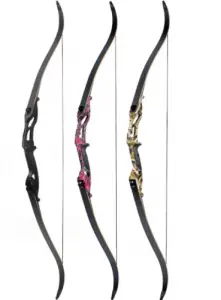
7. Maximum Distance
The maximum distance you can shoot a deer with a recurve bow differs for each bowhunter depending on his or her experience and skill level. The average successful shot at a deer is about 15 to 17 yards. A bowhunter should not shoot outside their effective range which is defined as the range they can keep their shots within a six-inch circle.
You should always try to get as close as possible to the target. Bowhunting is a close-range sport and decreasing the distance usually increases your chances of better shot placement. Knowing the maximum distance to shoot a deer with a recurve bow is crucial for ethical and successful hunting.
Unlike modern compound bows, recurve bows have shorter effective ranges due to their lower arrow speeds and less forgiving nature. Generally, the maximum effective range for shooting deer with a recurve bow is around 20 to 30 yards for proficient archers.
Beyond this distance, accuracy and penetration may become compromised, increasing the risk of injuring rather than cleanly harvesting the animal. Therefore, novice hunters learning to hunt with a recurve bow must diligently practice shooting at various distances to determine their effective range. By understanding their limitations and respecting the capabilities of their equipment, hunters can make ethical decisions in the field, ensuring humane kills and minimizing the risk of wounded game.
8. Recurve Bow Hunting Arrows
The hunting arrows have to be matched to your draw weight and draw length. The arrows should also be matched to each other in weight and spine or stiffness for consistency. You can learn how to hunt with bows in this article.
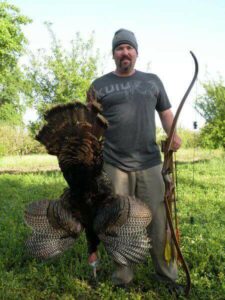
9. Learn The Physical Structure
Spend some time learning the physical structure of the whitetail deer. Additionally, learn where the vital organs are located on the whitetail deer. The heart-lung area of the deer should always be the target of the bowhunter. This area has the highest concentration of blood vessels. Hitting this area will be a fatal shot that will take the deer down. You can improve your deer hunting skills from this article on the best whitetail deer hunting tips.
Create a dummy of the deer with the vital target area marked out. Then practice hitting that area multiple times until you develop the skills to hit that area.
The best shot with a recurve bow is the quartering away shot. This shot allows the arrow to enter the animal through the softer meat and ribs behind the chest cavity and penetrate the heart-lung area with little to no resistance.
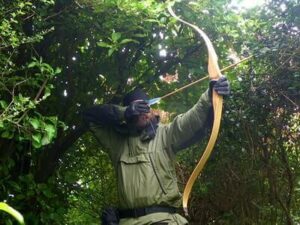
Recurve Bow Safety Tips
1. Always inspect your bows and arrows for cracks or damage.
2. Don’t ever shoot bent, cracked, or broken arrows.
3. Always use an arrow when firing a bow. Don’t “dry fire” a bow as it can damage it.
4. Properly secure broadheads. They can cause serious injuries and should be treated the same way you handle a loaded firearm.
How To Scout For Deer
How to scout for deer is an important skill to learn. When hunting for deer, there are deer signs that you should look for in an area.
1. Deer Tracks
When you are scouting an area for signs of deer activity, always look for deer tracks. Deer tracks will confirm that deer frequent that area. learn to read deer tracks as they can indicate whether they are the tracks of a buck, doe, or fawn. Additionally, the tracks can indicate if the deer left in a hurry or if it was casually moving. You can also learn which direction it went.
2. Deer Beds
Deer beds are another indication that deer are active in an area. Deer beds are little patches on the ground that appear clear as if something had been lying there. Deer beds are a good sign when you are scouting for deer.
3. Deer Scat
When you are scouting an area for signs of deer activity, always look out for deer scat or poop. This is a sure sign that the area is frequented by deer. Additionally, by studying the poop, you can learn what the deer are eating. if you can find the area with the plant or food shown in the poop, you just may have found a food source that you can set up close to.
4. Deer Scrapes
Deer scrapes are another sign of deer activity in an area. It also indicates that other bucks are also in competition for the doe in that area. Deer scrapes are often made by bucks as they use them to mark their territories from other dominant bucks. Bucks often urinate in their scrapes to mark their territory. The urination also attracts does to the scrapes and they also have a habit of urinating in the scrapes.
Recurve Bow Accessories
1. Arrows
The arrows are what is shot at the whitetail deer. Arrows are an essential accessory for a recurve bow, serving as the projectile that delivers kinetic energy to the target.
When selecting arrows for a recurve bow, several factors must be considered, including spine stiffness, length, weight, and tip type. The spine stiffness, or flex, of the arrow, must match the draw weight and draw length of the bow to achieve optimal flight and accuracy. Arrows that are too stiff or too flexible can result in erratic flight patterns and decreased accuracy.
Additionally, the length and weight of the arrows should be chosen to complement the shooter’s shooting style and preferences. Lighter arrows typically fly faster but may sacrifice penetration, while heavier arrows offer better kinetic energy transfer but may slow down flight speed.
Finally, the type of arrow tip, such as field points for target shooting or broadheads for hunting, should be selected based on the intended use of the bow. Overall, choosing the right arrows is crucial for achieving consistent and accurate shooting performance with a recurve bow.
2. Quiver
The quiver stores the arrows. A quiver is a fundamental accessory for a recurve bow, providing a convenient and secure way to carry arrows during shooting sessions or hunting trips. Typically attached to the bow or worn on the shooter’s body, a quiver keeps arrows within easy reach, allowing for quick and efficient arrow retrieval when needed.
There are various types of quivers available, including back quivers, hip quivers, and bow-mounted quivers, each offering unique benefits depending on the shooter’s preferences and shooting style. Back quivers are worn over the shoulder and allow for easy access to arrows behind the shooter’s back, while hip quivers are attached to the shooter’s belt or waistband, providing quick access to arrows at the hip.
Bow-mounted quivers attach directly to the bow itself, keeping arrows within arm’s reach for rapid reloading. Regardless of the style, a well-designed quiver helps ensure that arrows are organized, protected, and readily accessible, enhancing the shooter’s overall experience and performance with a recurve bow.
3. Finger Tab Or Glove
The finger tab is the finger guard for eliminating discomfort and finger slipping. A finger tab is a crucial accessory for archers using a recurve bow, providing protection and support to the fingers drawing the bowstring.
Made from various materials such as leather, synthetic materials, or even metal, finger tabs shield the fingers from the repetitive friction and pressure of drawing and releasing the bowstring, preventing discomfort, blisters, and calluses.
Additionally, finger tabs often feature a smooth or textured surface to ensure a consistent release of the arrow and enhance accuracy. Some finger tabs may also include an adjustable design to accommodate different hand sizes and shooting preferences, allowing archers to customize their equipment for optimal performance. Overall, a well-chosen finger tab is an essential accessory for recurve bow shooters, promoting comfort, control, and precision during every shot.
4. Recurve Bow Stringer Tool
The recurve bow stringer tool helps assemble your string to the bow easily, and quickly. A Recurve Bow Stringer Tool is an essential accessory for archers using recurve bows, facilitating safe and efficient stringing and unstringing of the bow.
Consisting of a durable cord with loops at both ends and a flexible pocket or limb cup, the stringer tool helps archers securely attach the bowstring to the bow’s limbs without risking damage to the equipment or injury to themselves.
To use the stringer tool, one loop is placed over the top limb tip, while the other loop is slid over the bottom limb tip, creating a stable anchor point for the bowstring. With the bow securely anchored, archers can then step on the stringer tool’s cord, flexing the limbs and safely allowing the bowstring to be slipped into place.
Conversely, when unstringing the bow, the stringer tool prevents excessive stress on the limbs by evenly distributing tension, preserving the bow’s integrity over time. Overall, a Recurve Bow Stringer Tool is a simple yet indispensable accessory for recurve bow enthusiasts, ensuring proper bow maintenance and prolonging the lifespan of their equipment.
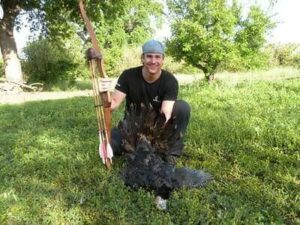
The Bottom Line
Hunting with recurve bows is challenging but rewarding as the accuracy is improved. In this article, we discussed how to hunt with recurve bows. There is a learning curve to get good at hunting with a recurve bow, but with a lot of practice, you can not only get good at it but also master it.
